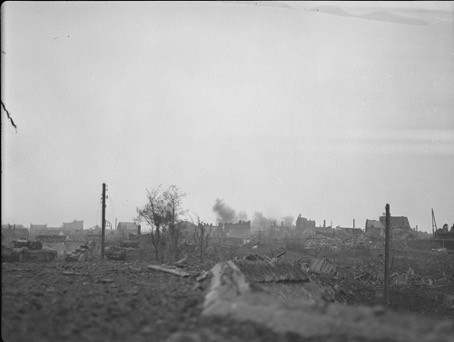Captain Harry Bailey, B Squadron 141 RAC (The Buffs), led a column of Churchill Crocodiles (flame-throwing tanks) to Breskens on 20 October. The squadron had been brought in specifically to besiege the extensive, German coastal defences. The Churchill flame-throwing tanks were part of a series of innovative weapons developed specifically to defeat the ingenious works of the Atlantic Wall.
Bailey wrote in his account that the next morning the steel tank tracks crushed the debris on the town access road. There was no more resistance in this part of Breskens and, working with the infantry, two groups were sent out to advance further. For the second time, part of Breskens fell under a huge rain of shells, and the big tanks, cloaked in huge clouds of dust, drove on across the plain of rubble. One of these steel monsters plunged into a huge shell pit, and the trailer carrying the supply of oil behind it sprung a leak and soon the pit filled with gallons of flammable oil. The crew quickly fled, and wisely stayed far away from the stranded tank.
They heard the unpleasant howl of a flamethrower from one of their colleagues further away. In Breskens harbour, the burning smell of fire then prevailed, after which 30 scorched German soldiers were carried off. Further on, short bursts of fire from a German machine gun forced the infantry to take cover. The Crocodiles sprayed the position with several doses of oil, after which the weapon fell silent. Finally, the last snipers in the town were brutally gagged with burning oil.
The tank soldiers then saw with satisfaction that the Canadian infantry occupied the entire village without any problems. Just then, the mail and piles of sandwiches arrived, completing the successful job.
